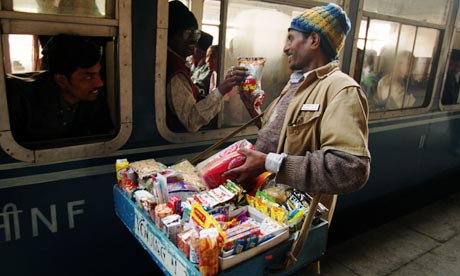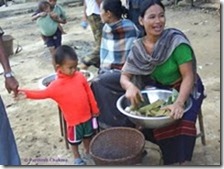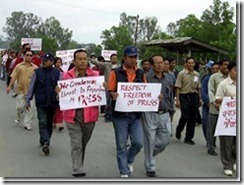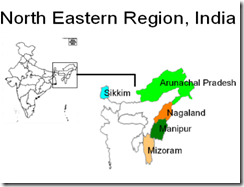By Ashley Tellis
 Mizo poet Mona Zote opens up about the process of writing; her north-eastern identity and life in general. ASHLEY TELLIS
Mizo poet Mona Zote opens up about the process of writing; her north-eastern identity and life in general. ASHLEY TELLIS
Part of my present frustration is rooted in the sense of not being able to piece together the shapes of my environment.
Creating word pictures: Mona Zote.
Mona Zote is a promising young poet from Mizoram. Her poems have appeared in various places — most recently in SPARROW'S Being Carried Far Away: Poems and Stories of Women in Assamese, Bengali, Garo, Manipuri and Mizo — and her enigmatic, assured poems are haunting and resonant. Here she speaks about the process of writing, about being from Mizoram and life in general
What are the influences on your work; the raw materials of your poetry?
Life, I suppose. Writing is partly an effort to make sense of things and partly an attempt to keep from going insane. The absurdity of life, the inherent strangeness of whatever is considered normal. People and their byzantine reasons for doing what they do.
Tell us a little about the process of writing? Do you do drafts? Do you revise?
Drafts and revisions, yes definitely. There are only two ways of writing a poem: either a line comes to you or you reach for that crucial line. It's always the first way for me. I usually don't get up from the chair until it's completed right up to the last word, after which the work of revising begins. The exception is ‘Rez', which turned into a peculiar never-ending process. I keep going back to it, so it's sort of still ongoing despite having been published. It escapes a finalised form. Like a tune that bothers you because you can't get it right.
Your poetry has a very assured tone and a world that the universe of the poem itself builds. Is this something that just comes to you or you work to create it?
Does it? I don't think I ever consciously worked towards building a world so it comes as a surprise to hear this. Although ‘world-building' in a Tolkien-esque sense has always been a favourite pastime since childhood, no doubt an outcome of constantly being on the move. So presumably it is something that just happens; that someone reading my poems might see. I don't particularly see it myself…in fact part of my present frustration is rooted in the sense of not being able to piece together the shapes of my environment. It's like standing too close to a stained glass window; you glimpse colours and suggestions of forms but the picture in its entirety is not discernible.
How important are the identities ‘Mizo' and ‘woman' to you as a poet?
They are inseparable at the moment. I might feel differently in the future.
Does your unpoetic job (Zote works with the Mizo government in the Income Tax Department) and your poetry inform each other at all?
They have very little to do with each other, which is just as well. Though working in a job that requires you to be scrupulously exact and logical all of the time has had an effect on the way I think, perceive and interpret things. Hopefully for the better and more likely for the worse.
Why don't you have a collection published as yet? Do you have one in your head?
I don't think anything I have written so far could comprise a collection, thematically or quantitatively. There are poems I wrote in Shillong and poems written in Aizawl and, somewhere between, during and after the two phases a kind of fatal break occurred that I have not been able to bridge with any degree of success. Right now I am struggling to write at all, so there's no thought of bringing out a collection soon; apart from my suspicion that poetry may not be the best means to deal with whatever one has been through here. Or it should be supplemented, maybe subverted.
What is it like working and writing in Aizawl?
Horrible and weirdly fascinating.
Who do you see as your community as a poet? Do you relate to mainland Indian poetry in English or other languages?
It's difficult to say. One could be glib about it but, to be honest, I think every poet is a community unto herself. By necessity we have to be. I have a deep sense of envy, for lack of a better term, for poets who are readily identifiable with the community they happen to be a part of, who are apparently seamless parts of that community. Or poets who effortlessly incorporate the local rather than talking about them from the perspective of an intrigued and observant outsider.
Well, insofar as there are common themes – of the sheer fact of being human and living out the universal human muck and mess – running through what we write, it's not hard to declare that one can relate to mainland Indian poetry in any language. I suppose the truth of the matter would be that the concerns of a poet writing in the Deccan heartland would be quite different from someone writing from the fringes of the country. Weigh in the factor of cultural separateness and one wonders how we could relate to each other's writings at all. But we do.
Do you write in Mizo as well?
No. A pity because there's so much uncharted territory in the language.
How do you respond to the quietude of post-insurgency Mizoram? How do you respond to the religious, patriarchal and political conservatism of the region?
That word ‘quietude' carries a little eddy behind it. There's a remarkable story – and now I am no longer sure if I merely dreamed I heard it – that right before the declaration of peace a thick cloud of butterflies drifted over the town out of the west. I sometimes think it was indeed a portent, just not the way the person who told me this story thought of it. We lost ourselves in the insurgency – an insurgency that need not have happened, by the way. Something left us. And we have grown a tissue over the wound but the scar is festering untended. People simply shut it out, they don't think about it on an active level yet the trauma filters through in small ways.
And while religion supposedly heals or consoles, it can also inflict a cultural damage that is difficult to diagnose or even acknowledge. The process of inquiry is beginning, though.
Mizo society is so inherently self-contradictory that it took me a while to see it's just the same old patterns of patriarchy and class at work here as elsewhere.








 Mizo poet Mona Zote opens up about the process of writing; her north-eastern identity and life in general. ASHLEY TELLIS
Mizo poet Mona Zote opens up about the process of writing; her north-eastern identity and life in general. ASHLEY TELLIS 



